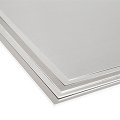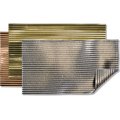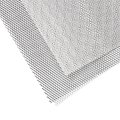Aluminium Sheet
Information about aluminum sheets
Aluminium (short: aluminium) belongs to the non-ferrous materials, is a very light metal and therefore of particular interest for aircraft and vehicle construction.
Aluminium production is very energy-intensive. Only about 1 % of the energy is needed to produce a comparable quantity of copper.
Application
Today the techniques are mastered and aluminium has developed into one of the most important technical materials of all. Due to its low weight and good strength, aluminium is used in transport, aircraft, rail and other motor vehicles.
In architectural model making, the sheets are suitable for the representation of metal facades or water surfaces, for example. Otherwise, aluminium sheets can be used well for the production of jewellery, for signs or as reflective surfaces.
Properties:
In the air, aluminium forms a thin oxide layer on the surface. It protects the metal from corrosion and weathering. Aluminium conducts heat and electricity well. It is tasteless and approved for contact with foodstuffs.
Melting point: 660 °C; Boiling point: 2060 °C Density
: 2.70 g / cm³ Electrical conductivity: 37.74 MS / m Thermal
conductivity: 230 W / mK
Processing:
Aluminium alloys are generally very easy to form, bend, press and forge. When driving with a hammer, the high springback of the material must be taken into account. Sharply curved edges tear easily. For this reason, the rolling direction of the sheet material should be as opposite as possible to the rolling direction.
Scissors and cutters are suitable for cutting thin aluminium sheets. Aluminium sheets with thicknesses over 0.5 mm can be processed with a saw or a sheet shear.
When machining aluminium sheets, good results are achieved with high cutting speeds and large rake angles. Drill bits should have narrow spirals. Lubrication and cooling with drilling emulsion or soapy water is advantageous.
Simple connections can be made by gluing. Reaction adhesives based on epoxy resin, polyurethane or cyanoacrylate are particularly suitable here. More stable bondings result from a slight roughening of the adhesive surface. Reaction adhesives are of course also suitable for bonding aluminium with other materials.
Our offer:
We supply aluminium sheets smooth, with various surface structures, coated and alloyed in thicknesses from 0.05 mm to 2.5 mm up to a plate size of 1000 x 2000 mm. Some aluminium sheets can be cut individually. You will find all relevant information on cutting the sheets directly on the products.




